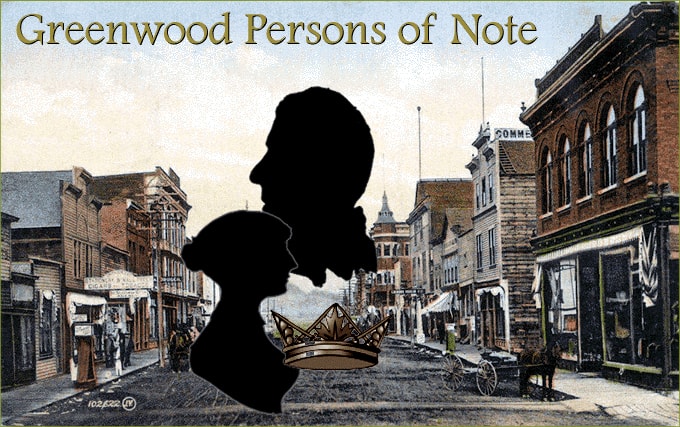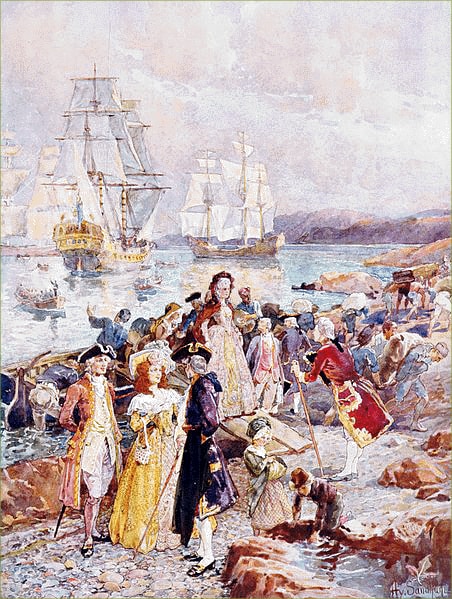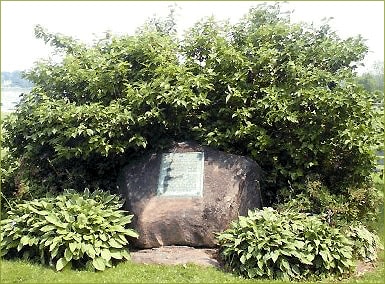


BY: BG EDITOR
Oct 08, 2016 — GREENWOOD, BC (BG)
Today we will talk about another of Greenwood's upstanding early citizens — William Grant Gaunce, who arrived here in 1898. He was involved in real estate and mining brokerage, and served as secretary for the Board of Trade for many years. William Gaunce and his wife both came from prestigious Loyalist families, and that historical connection brought William much respect in British Columbia.
In the book, British Columbia from the Earliest Times to the Present (Vol. III, 1914)[1], we find the following biographical information on William Gaunce
WILLIAM GRANT GAUNCE
The rapid development of the great northwest has furnished excellent fields of labor wherein the activity of men of energy, ambition and discrimination have proven resultant factors in winning prosperity. William Grant Gaunce, who is engaged in the real estate and mining brokerage business in Greenwood, came to this place in 1898. He was born in Carsonville, Kings county, New Brunswick, August 5, 1850, his parents being Christopher G. and Esther (Cook) Gaunce, both of whom are deceased.
He was educated in the public schools of his native city, in Superior school in Millstream and in the University of New Brunswick, completing a course by graduation in the last named institution with the class of 1873, winning the Douglas gold medal in his last year over a large number of competitors.
For a number of years he was identified with educational work, following the profession of teaching in the city and high schools of New Brunswick for six years, while for five years he was Inspector of schools. In 1884 he was sent to England on behalf of emigration and following his return to his native land he was for three years superintendent of agencies for the Confederation Life Insurance Company for New Brunswick and Prince Edward Island.
In 1889 he went to the state of Washington, where he remained for four years, or until 1893. In 1896-7 he conducted the immigration bureau of the state of Washington and in 1898 he came to Greenwood, where he has since made his home. Here he embarked in the real estate and mining brokerage business, in which he has since been engaged, and during the six years of his connection with this city he has secured a large clientage. Many important real estate transfers have been promoted through his efforts and he has handled much valuable mining stock.
In community affairs Mr. Gaunce has taken a very active and helpful part, withholding his co-operation from no measure which he believes will contribute to general progress and improvement. He has been secretary of the board of trade of Greenwood almost continuously since its organization and he was a member of the commission which settled the coal strike at Fernie, British Columbia, in March, 1903.
In 1875 Mr. Gaunce was happily married to Miss Eliza J. Atherton, of Frederickton, New Brunswick, and they have two children, Harold S. and A. Helen. Mr. Gaunce belongs to the Ancient Order of United Workmen and is a Conservative in politics, while in his religious belief he is a Congregationalists.
The field of business is limitless, its opportunities are many, and yet comparatively few who enter the world's broad field of battle come off victors in the struggle for success and prominence. This is usually due to one or more of various causes — superficial preparation, lack of close application or an unwise choice in selecting an avocation for which one is fitted. The reverse of all these has entered into the success and prominence which Mr. Gaunce has attained in the business circles of Greenwood, where he now has a wide and favorable acquaintance."
To the above biography, written during William Gaunce's lifetime, we can now add some additional details about his personal life. Genealogical records list William's birthplace as Studholm, New Brunswick. Studholm was the name of the Parish in Kings County. More specifically, he was born in a Kings County settlement called Millstream, in the general area known as Carsonville.[2]
About William's early life in Millstream, one local historian wrote: "In 1850, William Gaunce was born in this community and he overcame many hardships to obtain an education from Normal School and the University of New Brunswick."[3]
William and his wife Eliza Jane Atherton were married in 1875. She was born about 1854, and died in 1921, in Saanich, B.C. Of their two children, Harold Seabury and A. Helen, the oldest was Harold. He was born on September 4, 1876 in St. Stephen, N.B., where the family lived at the time, with William engaged as a school teacher.
By October, 1932, William had apparently relocated to Victoria, B.C., as evidenced by a Birth Registration filed on behalf of his son. It says that his son went with him from New Brunswick to Centralia, Washington, in Autumn of 1889.[4]
William Grant Gaunce passed away at the age of 85, September 28, 1935 in Saanich, B.C. His remains are buried in the Ross Bay Cemetery in Victoria.
Aside from his years of residence in Greenwood and his active participation in the community and on the Board of Trade (a topic we will explore further in a future article), one of the most interesting aspects of William Grant Gaunce's life story actually began several generations before he was born. His parents, Christopher G. and Esther (Cook) Gaunce, had five children in addition to William. There were four more sons — Zebulon, David L., Asa Smith and Isaac, and a daughter, Susan Sophia (Gaunce) Leiper.[5]
William's grandfather (Christopher Gaunce's father) was the patriarch of the line — Jeremiah Gaunce. Jeremiah was among the United Empire Loyalist families who settled in Canada in the mid-1700's. And not only were Jeremiah and his descendents among the Loyalists, so was the family of William's wife, Eliza Jane Atherton. In fact, many of the Loyalists had settled in New Brunswick. The Athertons were from Frederickton, and the Gaunces were in nearby Carsonville, New Brunswick.

The Coming of the Loyalists
[ Painting by Henry Sandham depicts the arrival
of the Loyalists in New Brunswick. Painted c. 1890 ]
The United Empire Loyalists (or UELs) were primarily American colonists who remained loyal to the British Crown. Many served under the British during the American Revolution, c. 1775-83. They and other Empire loyalists came to Canada, settling in the eastern provinces.
The name, 'United Empire Loyalists' was bestowed in 1789 by Lord Dorchester, the Governor of Quebec and Governor-general of British North America. He administered the distribution of land grants to the Loyalists, with many in Nova Scotia (including present-day New Brunswick) and Ontario. The arrival and settling of the Loyalists marked the beginning of a predominantly English-speaking population in future Canada, both west and east of modern Quebec's border.[6]
At the time of William Grant Gaunce's residence in Greenwood at the turn of the century, and even up to this day, being recognized as a Loyalist carried with it a particular social distinction. The impact the Loyalists had on Canada, and the resulting honor that was bestowed upon them, is described here:
"The arrival of the Loyalists after the Revolutionary War led to the division of Canada into the provinces of Upper Canada (what is now southern Ontario) and Lower Canada (today's southern Quebec). They arrived and settled in groups by ethnicity and religion.
Loyalists soon petitioned the government to be allowed to use the British legal system they were accustomed to in the American colonies, rather than the French system still in place after the fall of Quebec to Great Britain. The creation of Upper and Lower Canada allowed most Loyalists to live under British laws and institutions, while the French-speaking population of Lower Canada could maintain their familiar French civil law and the Catholic religion.
Realizing the importance of some type of recognition, on November 9, 1789, Lord Dorchester, the governor of Quebec and Governor General of British North America, declared "that it was his Wish to put the mark of Honour upon the Families who had adhered to the Unity of the Empire". As a result of Dorchester's statement, the printed militia rolls carried the notation:
"Those Loyalists who have adhered to the Unity of the Empire, and joined the Royal Standard before the Treaty of Separation in the year 1783, and all their Children and their Descendants by either sex, are to be distinguished by the following Capitals, affixed to their names: U.E. Alluding to their great principle The Unity of the Empire." [7]
In Canadian heraldry, Loyalist descendants are entitled to use an image of the Loyalist coronet in their coat of arms:

Loyalist military coronet (left) and Loyalist civil coronet (right)
That Greenwood's own William Grant Gaunce was known to be active among his brethren is evidenced in this brief statement on the travels of several Loyalists, who visited William just before he arrived in Greenwood. This report was published in the New Brunswick Reporter and the Fredericton Advertiser on October 8, 1890:
"Wesley Crewdson s/o W.J. Crewdson and John Kelley s/o Gordon Kelley, expect to leave Tuesday next for Washington Territory. They will probably push on to Centralia, the present home of our former townsman, W. Grant Gaunce."[8]
As mentioned above, the Loyalist lineage ran not only through William Gaunce's family line, but also through his wife's family. The father of William's wife, Miss Eliza J. Atherton, is here memorialized in The Fredericton Evening Capital[9], January 8, 1887:
"GEORGE R. ATHERTON breathed his last. He was in his 77th year and had been for some days been prostrated by an attack of apoplexy so that his death was not unexpected. He died at the residence of his son-in-law, W.G. GAUNCE and was buried Sunday in the Methodist cemetery. Rev. Dr. McLeod, of whose church the deceased had been a member, conducted the ceremonies at the house and grave.
Mr. Atherton was a descendant, in the third generation, of one of the United Empire Loyalists who after the Revolutionary war preferred the wilderness of New Brunswick. His name was Benjamin ATHERTON, an officer in the British Commissariat. He came to Fredericton and received a grant of a lot of land on which the Government House now stands. Here he continued for some time, engaging in the fur trade with the Indians who made St. Anne's (Fredericton) their periodical rendezvous. After a residence of some years he was offered his choice of lots between Fredericton and Woodstock in exchange for his grant. He chose Bear Island whither he removed to engage in farming and trading.
He had five sons, one of whom, Stephen ATHERTON was the father of the man laid to rest last Sunday. Stephen also had five sons, three of whom are still alive, namely, Israel ATHERTON and John ATHERTON of Fredericton and Stephen now in Nebraska. Benjamin, the other brother, died a few years ago, shortly after establishing the Royal Hotel. George R. Atherton had 12 children by his wife Rebecca Anne McKEEN d/o John McKEEN of Mactaquack. Four of these are still living — Robert ATHERTON in the civil service in St. John; William ATHERTON in British Columbia; Eliza ATHERTON wife of William Grant GAUNCE and George L. ATHERTON, Fredericton druggist."
The remainder of George R. Atherton's obituary is linked in the footnotes below, with additional information on the Atherton family Loyalists.[9]
William's father, the Loyalist patriarch Jeremiah Gaunce (Gonce) was born in 1751, in Holland, and died in 1824 in Gagetown, New Brunswick. He married Mary Ann Fitzgerald, of Limerick, Ireland. She was born about 1753 and died 1836 in Gagetown.[10] Jeremiah, his wife and one child are listed on the manifest of a Dutch ship that sailed to the U.S. He arrived in New Amsterdam (New York), and had three brothers who emigrated to the Ohio Territory. He then sailed from New York to Saint John on the ship Neptune, around 1783:
"8 ships arrived in Saint John (also known as Parrtown) from New York (also known as New Amsterdam) on about 17 October 1783 carrying 11 militia companies. The ship Neptune carried 3 militia units; the 50th, 51st and 52nd. The 51st unit, known as the Joseph Ferris, had a embarkation muster of 61. On page 202 Appendix VIII, Jeremiah Gaunce is listed as belonging to Unit 51."[11]
In 1821, Jeremiah and his eldest son Christopher (William's father) were both named on a land grant petition for Great (Upper) Musquash Island, N.B. He was awarded 15 acres there. Jeremiah died in 1824 and is buried in St. John's Anglican Church Cemetery, Gagetown, N.B.
In 1933, just two years before his death, William gave an address before the Victoria O.E.L. Society (Order of Empire Loyalists). The occasion coincided with a special dedication being made in Fredericton, N.B., where a memorial stone and plaque were erected in honour of the United Empire Loyalists who had settled there. Before the assembly in Victoria, William spoke of his early life and described how they prepared food to last them through the winter months.[12]
In William's speech, which was published in the Saint John newspapers, he said:
"My ancestors left the United States in 1783 and settled at Parrtown (now Saint John), later moving up the Saint John River and settling in and around Gagetown, in Queen's County. [ ] About 1840 my father left that section and with his brother-in-law, went across country about 50 miles to what is now known as Kings County. At that time it was known as the "Old Studholm Grant"."

Granite monument and 150th Anniversary Plaque commemorating the arrival
of the United Empire Loyalists in Fredericton, N.B. in 1783.
[ Installed on The Green and dedicated in 1933. The following year, a similar plaque
was installed at the Cornwall Post Office. ]
The installation ceremony at Fredericton was also covered in a news article in the Loyalist Gazette[13]:
"Memorial Unveiled To Early Settlers — Imposing Ceremony at Fredericton Attracted Large Gathering
"In the presence of a large representative gathering, a boulder monument in honour of Fredericton's first English-speaking settlers and the real founders of the city, a band of United Empire Loyalists, who landed here one hundred and forty years ago, was formally unveiled by His Honour Major-General Hugh H. McLean, K.C., LL.D., VD., Lieutenant Governor of New Brunswick, on Sunday afternoon. After unveiling the monument His Honour read the inscription on the bronze tablet, and then delivered a brief but forcible address in praise of the Loyalists and warmly commending the action of the citizens of Fredericton in honouring their memory. The other speakers were: Hon. L. P. D. Tilley, Premier of the Province, and His Worship the Mayor of Fredericton, W. G. Clark. The speeches were most appropriate to the occasion and were listened to with marked attention."
FOOTNOTES:
[1] British Columbia from the Earliest Times to the Present, Volume III - 1914
[2] Genealogy Records for William Grant Gaunce
[3] 'Settling in Millstream' - Website of Ruby Cusack
[4] Provincial Archives of New Brunswick
[5] Genealogy Records for William Grant Gaunce
[6] 'Loyalists' - Library and Archives of Canada
[7] United Empire Loyalists
[8] Loyalist Family Surnames: Gaunce
[9] Loyalist Family Surnames: Atherton
[10] Genealogy Report - Descendents of Jeremiah Gaunce
[11] Early Loyalist Saint John by David G. Bell, Fredericton N.B., New Ireland Press (1983)
[12] 'Settling in Millstream' - Website of Ruby Cusack
[13] Loyalist Gazette, Vol. III, No. 3, November 1933, p.10


